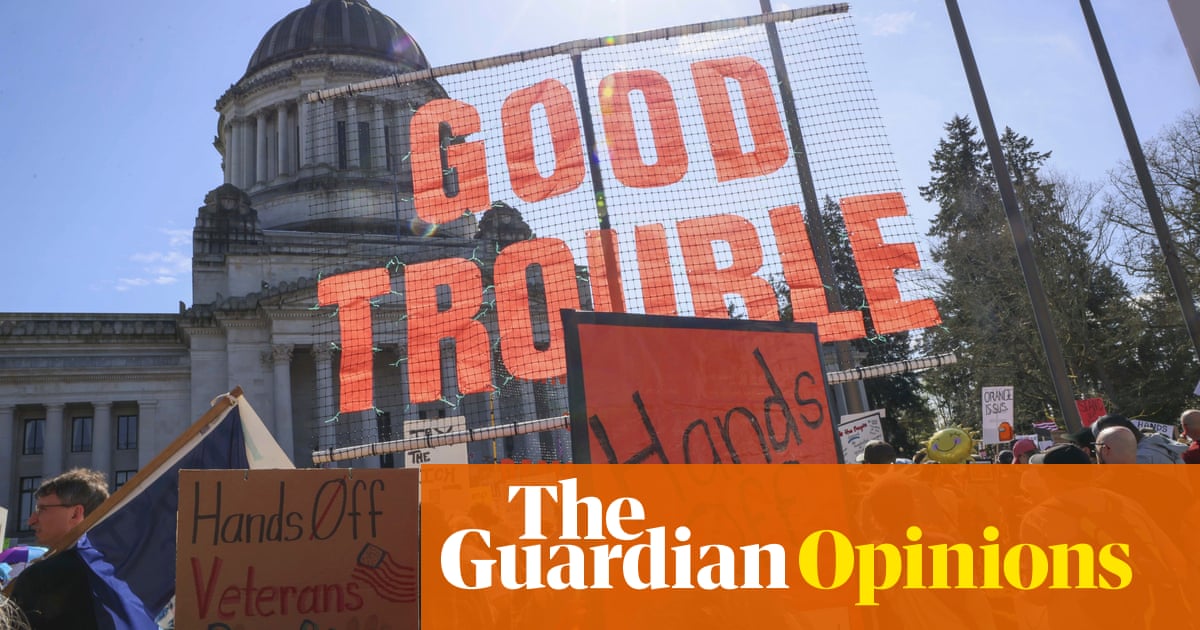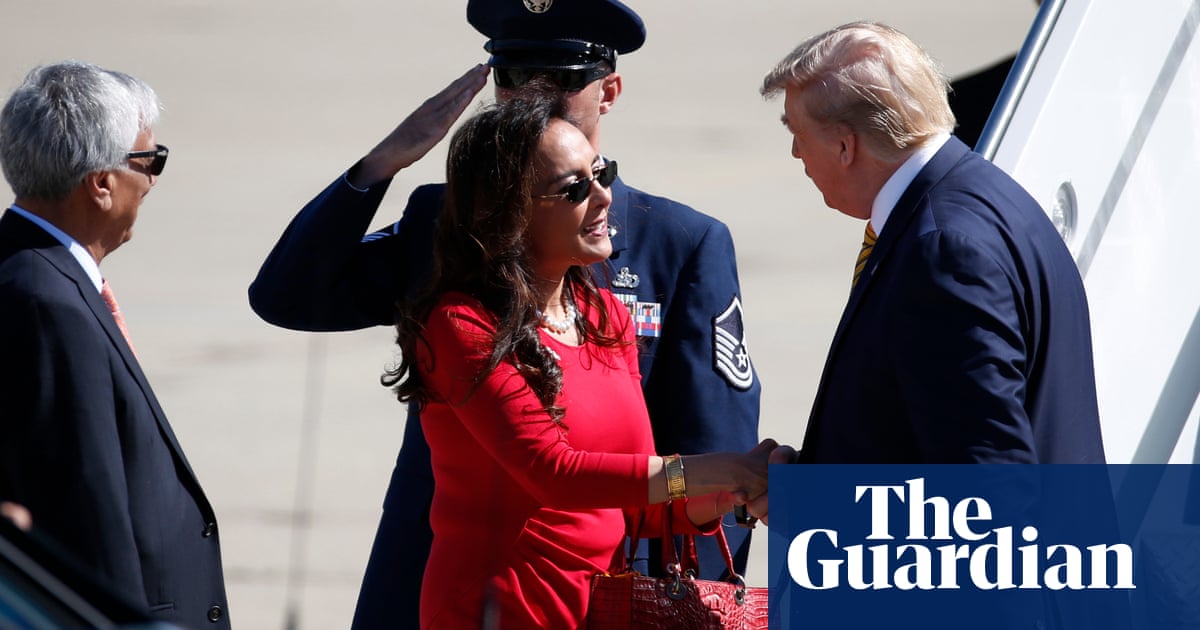The president has begun his second term at a whirlwind pace, slashing the government, upending international alliances, challenging the rule of law and ordering mass deportations
Law-abiding migrants sent to foreign prisons. Sweeping tariffs disrupting global markets. Students detained for protest. Violent insurrectionists pardoned. Tens of thousands of federal workers fired. The supreme court ignored.
The first 100 days of Donald Trump’s second term have shocked the United States and the world. On the eve of his inauguration, Trump promised the “most extraordinary first 100 days of any presidency in American history”, and what followed has been a whirlwind pace of extreme policies and actions that have reshaped the federal government and the US’s role in the world.
Let’s look at what he has achieved and destroyed.
Shattering alliances

The end of the postwar order
Trump’s first 100 days has been marked by arguably the biggest shake-up in US foreign policy since 1945. He has feuded with Nato and turned on Ukraine, slapped tariffs on US allies around the globe, ignored international institutions and publicly admired dictators from Vladimir Putin to El Salvador’s Nayib Bukele.
‘The EU was invented to screw us over’
Trump has called European allies “freeloaders” who have relied on the US to pay for their defense and said he would not defend allies who didn’t meet a spending threshold of 2% of GDP. He has accused European allies of conspiring to “screw over” the US by forming the European Union. “The west as we knew it no longer exists,” the European Commission president, Ursula von der Leyen, said.
Video-2: To view this video please download this article it in our app
A new Monroe doctrine?
As Trump has retreated from Europe, he has increasingly thrown the US’s weight around the western hemisphere. He said Canada should become the 51st state, threatened to annex Greenland, and proposed in his inaugural speech that the US “take back” the Panama canal. Some have compared his foreign policy to that of James Monroe, the former president who in 1823 declared a US sphere of influence in North and South America.

Tariffs and China
Trump’s haphazard imposition of tariffs has angered US allies from Europe to Asia, where longtime trade partners such as Japan, South Korea and Taiwan have scrambled to try to negotiate new deals to protect their economies from severe shocks. China’s Xi Jinping has toured south-east Asia, seeking to promote Beijing as the world’s protector of rules-based trade and calling on countries to “jointly oppose unilateral bullying”.

JD Vance, Elon Musk and the court of Trump
If Trump has seemed transactional toward Europe, then his top advisers have appeared downright hostile. JD Vance made waves in Munich when he portrayed European leaders as ideological tyrants and accused them of “running in fear of your own voters”. Musk has backed far-right movements from the UK’s Reform to Germany’s AfD.
Attacking rule of law
Pardoning January 6 protesters
Trump issued more than 1,500 pardons or commutations to people convicted in connection to the January 6 attack on the US Capitol.

‘He who saves his Country does not violate any Law’
– Trump in a February post on X, underscoring that he believes he can justify breaking the law

Defying court orders
In March, the Trump administration ignored an order from the US district judge James Boasberg to turn around a plane headed to El Salvador containing people alleged to be gang members. It was a staggering act of defiance.

Threatening judges
Trump and allies have threatened judges who have ruled against them. “This judge, like many of the Crooked Judges’ I am forced to appear before, should be IMPEACHED!!!,” Trump said in an 18 March post on Truth Social. Elon Musk, a top Trump adviser, has also called for impeaching judges and supported Republicans who champion doing so.

Attacking lawyers
Trump has used executive orders to punish law firms connected to rivals or that have taken on causes averse to his administration. Several firms have settled with Trump to avoid being punished. Others have successfully sued the administration.
Trade
wars

Threats
Trump did not wait to return to the White House before threatening China, Canada and Mexico with sweeping tariffs. These would be implemented on the first day of his second term, he declared. This was the first of many times Trump would attempt to use the threat of an economic assault to force countries to bend to his will.

Delays
For Canada and Mexico, the supposed deadline for threatened tariffs shifted from January, to February, to March. When tariffs were imposed, it was barely 48 hours before all goods covered by a previous trilateral trade deal were spared. Companies caught in the crossfire struggled to keep up.
Video-4: To view this video please download this article it in our app
‘Liberation’
Trump and his aides sought to bill 2 April 2025 – the day he presented sweeping tariffs on much of the world, including China – as “liberation day”. The plan lasted all of a week before it was watered down. All of the countries in the administration’s sights except China now face a blanket tariff of 10%, rather than the higher rates, after a global market sell-off and warnings of recession.
Markets crashing

Trade war
While Trump has repeatedly pulled back from the brink of all-out economic war with most countries, China is the exception. When Beijing retaliated against US tariffs, Trump hiked them further – leaving the world’s two largest economies spiraling into a tit-for-tat dispute. US tariffs on Chinese goods stand at 145%.

Confusion
Amid mounting concern over the impact of Trump’s volatile trade strategy on the economy, and the risk of recession, businesses of all sizes are attempting to grab a moving target. “Nobody knows what’s coming next,” John Cochrane, an economist at the Hoover Institution at Stanford University, observed recently.
Government ‘efficiency’

Musk ushered into government
On day one, Trump signed an executive order creating the “department of government efficiency” (Doge) – a novel initiative chaired by Elon Musk. In the weeks that followed, Doge staff, many of whom are former employees at Musk’s companies and lack government experience, embedded themselves in federal agencies large and small, directing sudden and disruptive cuts to programs and payrolls.

Federal workers targeted
The Trump administration moved to dramatically shrink the federal workforce, first by proposing buyouts. About 75,000 employees opted to leave, as did thousands more in the weeks that followed. But the numbers were fewer than the White House hoped, so cabinet secretaries fired tens of thousands more, while Trump approved the termination of about 25,000 employees on their probationary periods. The supreme court refused to hear a challenge to the latter firings in April.

Agencies shuttered, perhaps illegally
Trump moved to dismantle USAID, which has administered Washington’s foreign aid agenda for more than six decades, and fold it into the state department. He also directed the education secretary, Linda McMahon, to oversee the closure of her department. The offensives against these and other agencies quickly wound up in the courts.

Doge rattles Trump’s cabinet
Doge has left few corners of the federal government untouched. But reports have emerged that Musk’s initiative is grating some of Trump’s newly confirmed cabinet secretaries, who see him as unhelpfully disrupting their departments. In March, Trump reportedly stopped Musk from seeing the defense department’s secret plans for a potential war with China during his visit to the Pentagon, noting that the Tesla boss had extensive business interests in China.
Musk takes a stand in Wisconsin – and loses
Musk was a major financial supporter of Trump’s campaign to return to the presidency. But his foray into the race for a Wisconsin supreme court seat in April was not as successful. Although he spent about $20m supporting the former Republican attorney general Brad Schimel, voters instead choose the Democratic-backed Susan Crawford, preserving the 4-3 liberal majority on the state’s highest court.
Information war

Flooding the zone
Trump has been everywhere all the time, dominating the “attention economy” like no other public figure. He takes questions from reporters far more often than his predecessor Joe Biden. He posts frequently on his Truth Social platform. He has attended the Super Bowl, Ultimate Fighting Championship and other sporting events.

The White House banned the Associated Press from events in the Oval Office and Air Force One over the news agency’s refusal to obey Trump’s executive order renaming the Gulf of Mexico as the Gulf of America. The AP sued over access to presidential events and won a court ruling, though it was unclear if and when the White House would put it into effect.

Platforming Maga media
The White House took over deciding which outlets are allowed to take part in the press pool, a group that acts as the eyes and ears of the media covering the president up close, and included more fringe outlets. Rightwing journalists also became more prominent at press briefings.

Challenging state funding
More than 1,300 Voice of America journalists, producers and assistants were placed on leave, crippling a broadcaster that was founded in 1942 to counter Nazi propaganda and operates in almost 50 languages. Grants to Radio Free Europe/Radio Liberty and Radio Free Asia were terminated. A judge recently ordered the restoration of Voice of America’s operations, but the administration is likely to appeal.
Executive orders
Trump increasingly relies on executive orders
Trump has signed 140 executive orders in his first 100 days, including 36 in his first week in office. His use of the presidential pen is unprecedented in modern US history. Below are the number of executive orders presidents signed in their first 100 days.

‘Invasion’ at the border
Trump’s day one border emergency declaration deployed 1,500 active-duty troops alongside 2,500 national guard members to the southern border. Framing migration as an “invasion”, the order militarized immigration enforcement and redirected defense resources to border control, raising serious legal and humanitarian concerns about the use of the military for domestic enforcement.

‘Deep state’ purge
The reinstated “Schedule F” executive order has stripped tens of thousands of federal employees of civil service protections, allowing the administration to fire career officials deemed disloyal.

Pro-Palestinian targets
A week after the Columbia graduate and green card holder Mahmoud Khalil was detained in March, Trump signed an order called “Securing American Values” to target visa holders who have participated in pro-Palestinian demonstrations. The order directs immigration agencies to authorize visa revocations of demonstrators linked to organizations accused of hate speech, and detain and expedite deportations for those involved in activity the administration deems antisemitic.

Birthright citizenship attack
Trump’s unconstitutional day one executive order aimed to end automatic citizenship for babies born on US soil to undocumented immigrants or those on temporary visas – directly challenging the 14th amendment’s guarantee that “all persons born or naturalized in the United States” are citizens. The order remains blocked by courts pending litigation.

Global aid freeze
The administration’s foreign aid freeze has halted thousands of humanitarian and development programs worldwide. The executive order targeting USAID has disrupted even life-saving health initiatives like HIV treatment in Africa, even though the administration says they have not been affected.
Fortress America
Video-1: To view this video please download this article in our app
Refugee admission suspended
Trump has suspended all refugee resettlement into the United States, leaving tens of thousands of people in an overseas limbo. The indefinite pause on the resettlement program has made it nearly impossible for refugees fleeing war and violence to seek safe haven in the US. The order is subject to ongoing legal action.
Arrests ramp up
US Immigration and Customs Enforcement (Ice) arrests in February outstripped not just the same period under Biden but even the figures from Trump’s first term.

Alien Enemies Act
The Trump administration used an 18th-century wartime law to deport scores of Venezuelans to El Salvador, where they are being held in a draconian mega-prison known as Cecot. Trump’s use of the law faces legal challenges. Onboard one of the deportation flights was a Maryland father with protected legal status mistakenly deported in what the administration called an “administrative error”. The supreme court has ordered the US to “facilitate” his return.

Free speech crackdown
In an extraordinary crackdown on free speech, the Trump administration has tracked down and detained international students involved in pro-Palestinian protests, among them Mahmoud Khalil, a Columbia graduate and lawful permanent resident.

Schools and churches no longer out of bounds
The Trump administration now allows immigration authorities to make arrests in schools, healthcare facilities and places of worship. But on 7 April, federal agents were denied entry to two Los Angeles area elementary schools after they alleged the children entered the US without documentation.
Opposition and protest

Protesters take to the streets
After a slower start than Trump’s first term, protests have erupted across the country, including in small towns in Republican areas, standing up against his overreach. Established groups have joined together with a decentralized protest movement around broad messages against oligarchy and dismantling democracy.

Musk is targeted
Elon Musk proved a potent target for the opposition, given his prominent role leading Doge as it slashed through the federal government. As Doge cut through agency after agency, people turned up outside federal offices in opposition. “Tesla Takedown” protests at local dealerships went after his publicly traded company, tanking the stock.

Democrats take a stand
After a bruising electoral loss, Democratic officials struggled to find their voices as an effective resistance to an emboldened Trump, but some have found a footing. Bernie Sanders and Alexandria Ocasio-Cortez launched an anti-oligarchy tour, drawing huge crowds. Some Democrats, including Congressman Al Green, disrupted a joint session of Congress. Cory Booker gave a record-breaking 25-hour speech on the Senate floor. Meanwhile, the party announced a new effort to funnel money into critical state races.
Video-3: To view this video please download this article in our app
Lawsuits put brake on Trump agenda
A strategy that worked well in the first Trump term remained a major plank of the opposition: endless lawsuits. A coalition of Democratic attorneys general have brought handfuls of suits, often successful, to stop his actions. Outside groups have filed lawsuits over his unconstitutional plans. But his administration is defying court orders in some instances, a sign that the courts alone won’t be enough to stop him.
Trump’s approval flipped
Net approval rating
Trump’s first 100 days were largely designed to make a statement, and they achieved that goal. But it’s clear that within this time period there have been consequences to the executive orders, policy making and budget cuts that could continue to spiral out of the president’s control.
The impacts will crystallize in the lives of the American public, and abroad, in the more than 1,300 days to come.

 German (DE)
German (DE)  English (US)
English (US)  Spanish (ES)
Spanish (ES)  French (FR)
French (FR)  Hindi (IN)
Hindi (IN)  Italian (IT)
Italian (IT)  Russian (RU)
Russian (RU)  5 hours ago
5 hours ago
























Comments